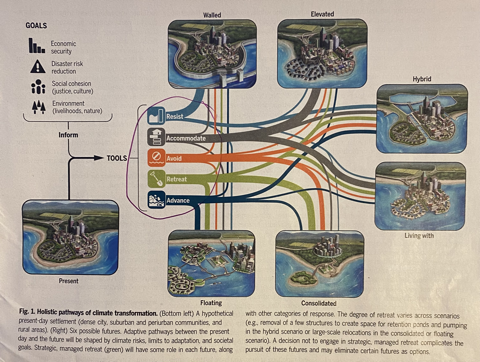
Life Science knowledge base of concepts & misconceptions
Questioning is the basis of all learning.
- Organisms
- What is living?
- Ecosystems
- Heredity &
- Evolution
- Genes - notes on editing & horizontal gene transfer
********************
- Science knowledge base home directory of concepts & misconceptions
Introduction
Last edited - April 10, 2024
Organization of life science dimension
Category
Misconceptions -
Initial perceptual naive ideas for all ages
(Explanations for people's misconceptions: naive understandings & perceptual responses)
Beginning concepts (preschool - 7 years)
Intermediate concepts (7 years - 11 years)
Literate concepts (11+)
Educator notes
Life science categories
Organisms (Bacteria, Eukaryota (plants, animals (human anatomy), fungi,), Archaea)
- Structure & Function (Behavior, Adaptation, Diversity, Disease
- Growth & Development (Reproduction, Life cycles,
- Organization of Matter & Energy flow (
- Information Processing (Interactions, Adaptation, Relationships, Social Interactions and Group Behavior
- Human organisms/anatomy - Human identity; Anatomy (structure) & basic functions of life, growth, & development; Health & safety, disease physical, mental/emotional, distress and treatment
- Humans and Animals compared ...
Ecosystems (Populations, Environmental factors, Environments, Communities)
- Interdependent Relationships in their Environment & Ecosystems
- Matter & Energy Flow, Transfer & Cycles
- Dynamics, Functions, & Resilience
- Social Interations & Group Behavior ( Interdependent Functions Relationships & Resilience
- Inheritance of Traits
- Variation of Traits
- Evidence of Common Ancestry (Unity) & Diversity
- Natural Selection
- Adaptations
- Biodiversity and Humans
Organisms
Misconceptions - Initial perceptual naive (any age)
(Explanations for people's misconceptions: naive understandings & perceptual responses)
Organisms
- Any object that moves is living. (Machines, smoke, clouds, fire, moving water...)
Non living is dead. - Plants are not living.
- Living and growing movement makes an animal alive, a seed is dead, all living organisms make noise.
- Plants are not alive. because they do not move…
- Students will sometimes say that plants breathe and grow but still do not see them as alive.
- Need to talk, walk, or breathe to be alive
- Can't link the same properties that are associated with animals being alive to plants.
Plants
- Plants are not living
- Plants absorb food through their roots.
- Oxygen, Carbon dioxide, water, minerals is food
- Seedlings are plants or living, trees are not
- Grass, trees, and other plants die in the winter and are born in the spring
- Plants eat artificial food, nutrients, water
- Plants bring up soil, water, minerals to get food
- Need sugar to survive.
- Leaves change color because they don't have much moisture, get dry, and turn brown
- The temperature changes and leaves can't survive so they drop off.
- Trees hibernate like animals.
- When the weather gets cold plants don't get as much sun and rain and die.
- Seeds are soemthing other than seeds.
- Seeds need soul to sprout.
- Seeds need sun or light to grow.
- Seeds are the color of the plant.
Animals
- People are not animals.
- Birds, fish, insects, worms are not animals.
- Chickens aren't birds.
- All animals can move from place to place
- Animals are four footed, or furry.
- Animals are wild, pets, or farm animals.
- Animals are large.
- Animals live on land.
- Insects can’t live in water.
- Spiders are insects
- Fish don’t need air, fish sleep with their eyes closed.
- Snakes don't have bones.
- Worms are tiny snakes.
Mammals
- have four legs
- live on land
Fish
- include dolphins, whales and sometimes seals
Bees
- Have bones for support
- Can not fly fast or far
- There are king bees
- All bees live in hives
- Hives are made of grass and twigs
- Bees are dangerous they are poisonous and will sting you
- Bees will sting you repeatedly
Behavior and Adaptation
- Living objects can change to meet their survival needs.
Regulation and Behavior
- Plants absorb food through their roots.
Reproduction
- Grass, trees, and other plants die in the winter and are born in the spring.
Clone
- The clone is actually the same person.
- A clone could be made to spare the life of a dying person.
- A clone would not have a soul.
- You could own a clone. Believe you could create an army of zombie like clones to take over the world.
- A clone would not be a normal organism.
- Cloning is creating life.
- Cloning is not a natural process.
- A clone will have the same feelings and emotions as its genetic parent.
- Great people could be reborn.
Microorganisms and disease
Educator notes
Concepts Beginning (preschool - 7 years)
Organisms , Behavior, Diversity, Adaptation, and Survival
- Orgainsm is a living object.
- Plants and animals are the same and different.
- Organisms need food, water, and shelter to survive.
- The behavior of individual organisms is influenced by internal cues (such as hunger) and external cues (such as changes in the environment).
- Plants and animals have features that help them survive in different environments.
- Stories sometimes give plants and animals properties they do not have.
- Humans and other organisms have senses that help them detect internal and external cues.
- Each plant and animal have different structures that serve different functions in growth, survival, and reproduction (humans have distinct body structures for walking, holding, seeing, and talking)
- Different plants and animals have structures that help them live in different places.
- Some kinds of organisms, that once lived on Earth, have completely disappeared (are extinct).
Reproduction and Life Cycles
- Plants and animals reproduce plants and animals similar to their parents.
- Plants and animals have life cycles that include being born, developing into adults, reproducing, and eventually dying.
- Plants and animals closely resemble their parents but not exactly.
- There are differences among individual organisms of a species.
Microorganisms and disease
- Plants, and animals (people are animals) get infections from other organisms (germs).
Educator notes
Concepts Intermediate (7 years - 11 years)
Organisms , Behavior, Diversity, Adaptation, and Survival
- Organism is the material structure of an individual life form. E.g. an individual animal, plant, or single-celled life form.
- All living organisms have basic needs, (animals need air, water, food, and shelter; plants need air, water, nutrients, light, and shelter).
- All organisms have similar needs and structures.
- All living organisms
- Use (metabolize) food for energy - to move,
- Grow, (require nutrition)
- Use oxygen (respire),
- Use water,
- Reproduce, (Species must reproduce to survive.)
- Respond to the environment (sensitivity),
- Grow, (Plants and animals may change in appearance a little or a lot as they grow.)
- Excrete waste
- All organisms must have their basic needs met to survive.
- Organisms must have optimum ranges of food, light, heat, water, and shelter met to survive.
- Organisms can survive only in environments in which their needs can be met.
- Organisms can be organizations of cells.
- Important levels of organization for structure and function include cells, organs, tissues, organ systems, and organisms.
- Groups of specialized cells cooperate to form a tissue, such as a muscle.
- Different tissues are grouped together to form larger functional units, called organs.
- Each type of cell, tissue, and organ has a distinct structure and set of functions that serve the organism as a whole.
- Systems interact with one another.
- The human organism has systems for digestion, respiration, reproduction, circulation, excretion, movement, control and coordination, and for protection from disease.
- Similarities among organisms internal features infer a degree of relatedness among them.
- Living organisms can be sorted (classified) into groups in many ways by their common properties. (Smallest group is species.)
- Properties used for grouping depends on the purpose of grouping.
- Internal and external features are used to classify organisms.
- All species are similar and different.
- Adaptation is a change in a species or individual that improves its condition or relationship to the environment.
- Some organisms that lived long ago are similar to organisms that live today while others are different.
- Some individual differences provide better opportunities for surviving and reproducing.
- Extinction means there are no living organisms of a certain species.
- Adaptation is a change in a species or individual that improves its condition or relationship to the environment.
- Animals migrate to adapt to environmental seasonal change. Hoofed animals (bighorn sheep, moose) learn migratory behaviors from their herd members while migrating.
Reproduction, Life Cycles, and Heredity
- Cells continually divide to make more cells for growth and repair.
- Each different organism has a life cycle that is different from other organisms
- In many species, including humans, females produce eggs and males produce sperm.
- Plants also reproduce sexually, the egg and sperm are produced in the flowers of flowering plants. Properties of flowering plants include: flower shape, color, nectar, & scent.
- An egg and sperm unite (fertilization) to begin development of a new individual.
- That new individual receives genetic information from its mother (via the egg) and its father (via the sperm).
- Sexually produced offspring are never identical to either of their parents.
- Many characteristics of an organism are inherited from the parents of the organism, but other characteristics result from an individual's interactions with the environment.
- Inherited characteristics include the color of flowers and the number of limbs of an animal.
- Other features, such as the ability to ride a bicycle, are learned through interactions with the environment and cannot be passes on to the next generation. This infers a way to transfer genetic information from one generation to another.
- Stem cells are undifferentiated cells of a multicellular organism which are capable of making indefinitely more cells of the same type, and from which certain other kinds of cells can arise by differentiation.
Clone
- A clone is in many ways like identical twins. They have the same DNA, they may look the same but they have unique experiences and memories. They are two different people.
Microorganisms and disease Concepts
- Microorganisms can cause disease.
- Most microorganisms do not cause disease and many are beneficial.
- Disease is a breakdown in structures or functions of an organism.
- Disease is essential to decompose organism.
- Decomposition is a way to recycle materials.
Educator notes
Stem cell engineering
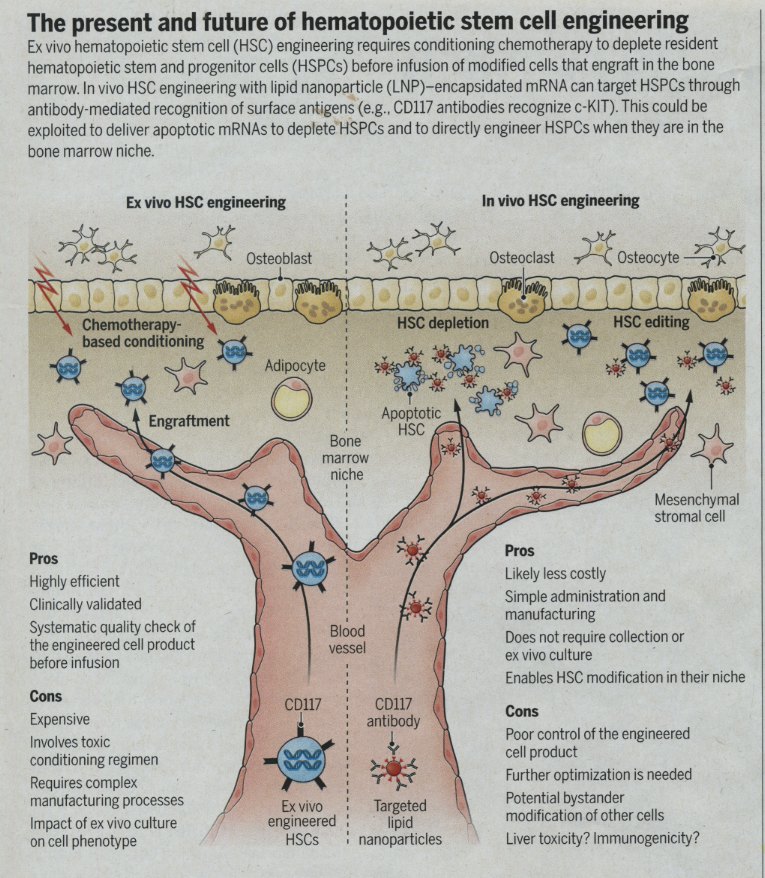
Concepts Literate (11+)
Organisms , Behavior, Diversity, Adaptation, and Survival
Living organisms are self-sustaining chemical systems (living forms) capable of Darwinian evolution. Key properties include: a chemical system, grow, reproduce, and provide energy (metabolism) for life through their genetic and molecular components through Darwinian evolution (system with genetic inheritance of DNA).
The basic structure that allows this is the cell. Cells grow, reproduce (or prolifereate), send information (signals), sense information (signals), move, change shape, stick to other surfaces (adhere), differentiate, and die. Learning about cells and how they function will improve the decisions we make for healthy living.
- Organisms have been classifed into six kingdoms: Archaebacteria, Eubacteria, Protist, Fungi, Plant, and Animal. Teacher notes for analysis of living or different life forms.
- Organism may also be grouped as viral and nonviral life. With nonviral organisms classified into three or four groups of organisms or life forms:
- Eukaryote a cellular organism (one or more cells) with DNA in the form of chromosomes within a distinct nucleus (protists, plants, algae, fungi, & animals)
- Bacteria, and
- Archaea. Prokaryotes include bacteria, cyanobacteria, and archaea (archaebacteria). Prokaryotes have no nuclear membrane, no organelles in the cytoplasm except ribosomes, and has its genetic material in the form of single strand of coils or loops.
- Lokiarchaeota appears between archaean and ekaryotes.
- Phages are viruses that infect bacteria.
- Phages are bacterial viruses. Phages can be used as an antimicrobial remedy to attack noncommunicable diseases (NCD). Their ability to target specific bacteria and minimize damage to surrounding bacteria is a plus. However, a negative can be antiphage resistance and discovering phages to use to target specific bacteria.
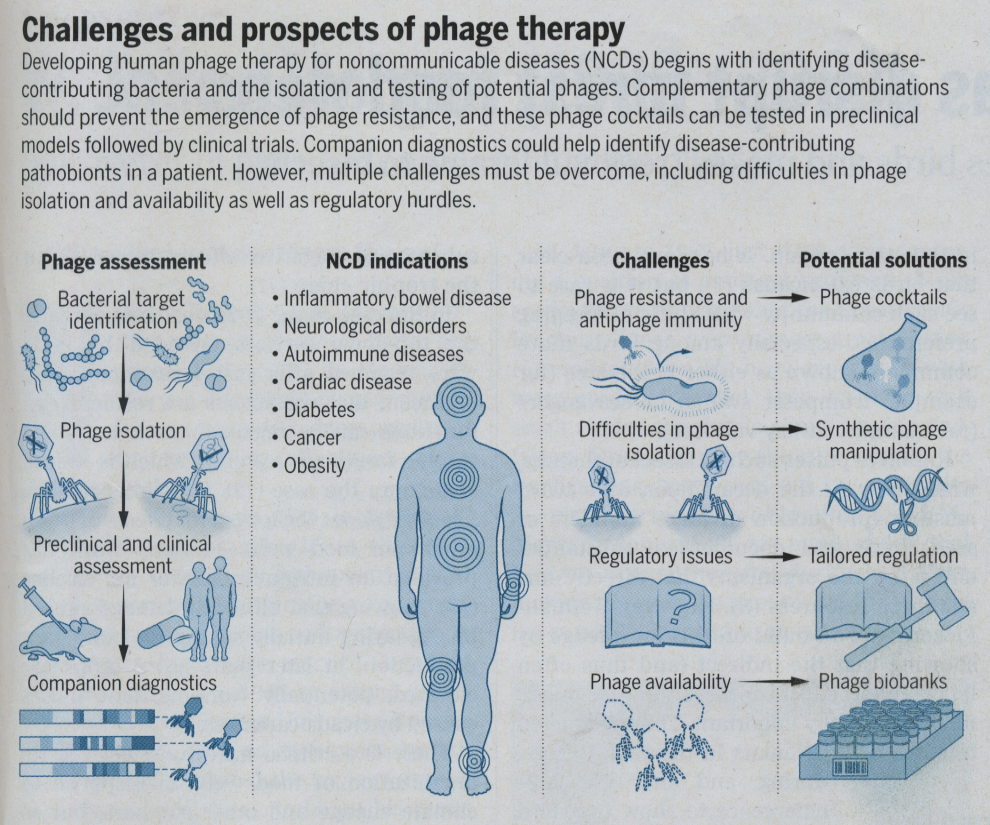
- Living systems and ecosystems at all levels of organization demonstrate the complementary nature of structure and function.
- Animals consume energy and plants use sunlight to make their food.
- Some organisms can not be easily classified as only a plant or animal.
- All organisms are composed of cells, the fundamental unit of life.
- Most organisms are single cells; other organisms, including humans, are multicellular.
- Cells carry on the many functions needed to sustain life.
- Two-thirds of a cell is water.
- Cells take in nutrients to provide energy for the work that cells do and to make the materials that a cell or an organism needs.
- Specialized cells perform specialized functions in multicellular organisms.
- An organism's behavior evolves through adaptation to its environment.
- Species is a group of living organisms with agreed on similarities or common attributes (or properties) designated by a common name. The most notable property is being able to exchange genes or interbreed.
- Species is a taxonomic unit, below genus. e.g. Homo sapiens.
- Species must reproduce to survive.
- Species includes all organisms that can mate with one another to produce sexually fertile offspring.
- Millions of species of animals, plants, and microorganisms are alive today. Although different species might look different, the internal structures among organisms is similar, their chemical processes, and common ancestry. Biological evolution explains how the diversity of life and the uniqueness of each species' properties developed through a slow processes over many generations through biological adaptation, which involves the selection of naturally occurring variations in populations, which include changes in structures, behaviors, or physiology that enhance survival and reproduction success in a particular environment.
- How a species moves, obtains food, reproduces, and responds to danger are based in the species' evolutionary history.
- Most mammal species are male dominant. Exceptions include: ruffed and ring-tailed lemurs, spotted hyenas, killer whales, African lions, bonobos, and two types of elephants. The Lion King should be the Lion Queen and female lions rule.
- Small differences can accumulate in successive generations so that descendants are very different from their ancestors. Individual organisms with certain traits are more likely to survive and reproduce. Changes in environment can affect the survival of individuals and entire species.
- Extinction of a species occurs when the environment changes and the adaptive characteristics of a species are insufficient to allow its survival.
Fossils indicate that many organisms that lived long ago are extinct. Extinction of species is common; most of the species that have lived on the earth no longer exist. - Organic means related to living or from derived from living matter. Organic compounds always have carbon (most inorganic compounds do not have carbon) and hydrogen or C-H bonds. Having carbon is not sufficient for a compound to be organic. Look for carbon and hydrogen. Examples: Sugar or sucrose (C12H22O11), benzene (C6H6), methane (CH4), ethanol or grain alcohol (C2H6O). See chemistry
Reproduction, Life Cycle, and Heredity
- A species includes all organisms that can mate with one another to produce sexually fertile offspring.
- Organisms are collections of cells.
- Cells grow and divide - thereby producing more cells.
- Reproduction is a characteristic of all living systems.
- No individual organism lives forever. Therefore, reproduction is essential to the continuation of every species.
- Some organisms reproduce asexually and other organisms reproduce sexually.
- Genetic characteristics are passed from only one parent (asexual) or two parents (sexual) reproduction.
- Every organism requires a set of instructions for specifying its traits.
- Heredity is the passage of these instruction from one generation to another.
- Heredity information is contained in genes, located in the chromosomes of each cell.
- Each gene carries a single unit of information.
- An inherited trait of an individual can be determined by one or by many genes, and a signal gene can influence more than one trait.
- A human cell contains many thousands of different genes.
- New varieties of plants and animals have been cultivated through selective breeding and gene splicing.
- While genes are important parts of DNA, they are not the whole picture. DNA includes about 95% extragenic material that also plays a regulatory role in gene expression. THis does not decrease the importance of genes, but increases it with a need to understand gene regulation and epigenetic factors in the role of growth and reproduction.
Microorganisms and disease
- Most microorganisms do not cause disease and many are beneficial.
- Disease is a breakdown in structures or functions of an organism.
- Some diseases are the result of intrinsic failures of the system.
- Others are the result of damage by infection of other organisms.
- Disease contagion variables
- Type of organism
- Method of infection
- Organism's life cycle
- Surveillane of health conditions
- Number of cases in first wave of infection
- Time between generations
- Types of organisms infected of harbor disease
- Detection ease, Time to confirm infection, availability of testing, ease of testing, similarity to other organisms and diseases, new disease or known disease
- Availability of antibodies
- Mortality rate
- Percentage of fatal cases
- Sanitary conditions, deforestation, urbaniztion, agriculture density, native species, availability of potable water
- Availability of heath services. Medical clinics. Doctors, hospitals, health care,
- Communication
- Political, local, organization and trust of information, networking, leadership, and communication
Educator notes
- Vaccination data sheet
- Evolution teacher's guide at Project 2061
- Bird flu tree. Avian influenza virus (AIV) and H5N8.
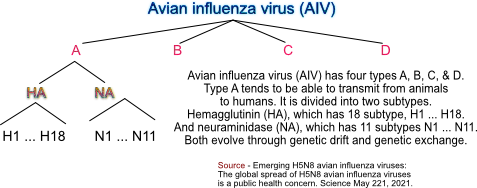
Life - living, organisms,
What is living?
Analysis of different life forms:
Archaea. Prokaryotes include bacteria, cyanobacteria, and archaea (archaebacteria). Prokaryotes have no nuclear membrane, no organelles in the cytoplasm except ribosomes, and has its genetic material in the form of single strand of coils or loops.
- Examples - microbes in your gut, extremiphiles living in deep sea vents
- Madke of - a single, simple cell with no nucleus or membrane bound organelles
- Can evolve
- Grows and responds to stimuli and mantains a metbolism
- Reproduces - asexually splitting or budding into new organisms
- Alive? - Yes
- Examples - E. coli, salmonella
- Made of - A simple cell without a nucleus,like archaea, but with different cell walls.
- Can evolve
- Grows and responds to stimuli and mantains a metbolism
- Reproduces - Asexually splitting like archaea, or exchanging and recombining genetic information with other bacteria in a process called conjugation
- Alive? - Yes
Eukaryote a cellular organism (one or more cells) with DNA in the form of chromosomes within a distinct nucleus (protists, plants, algae, fungi, & animals)
- Examples - Plants, animals, fungi, and most multicellulare organisms
- Made of - A complex cell or cells
- Can evolve - ask Darwin
- Grows and responds to stimuli and mantains a metbolism
- Reproduces - Sexually or asexually recombining genetic information material into new iterations through mitosis or meiosis.
- Alive? - Yes
Viruses
- Examples - SARS-CoV-2, influenza, herpes,
- Made of - a tangle of genetic material in a protein shell
- Can evolve - Yes when errors aremade in the process of copying itself, the errors that help it spread and have moreopportunities to continue to exist
- It does not grow and respond to stimuli and mantain a metbolism
- Reproduces - by hijacking a cell's molecular machinery and making copies of itself.
- Alive? - Most biologist say no.
Prions
- Examples - proteins that cause mad cow disease, Crreutzfeldt-Jakob disease
- Made of misfolded proteins
- Does not evolve, but new forms can be made and then copy themselves
- Does not grow and respond to stimuli and mantain a metbolism
- Reproduces like dominos as one protein misfolds, then the others around it will too. It's chemistry.
- Alive? - No
Be careful when considering what organisms can survive:
Research the immortal jellyfish and tardigrade:
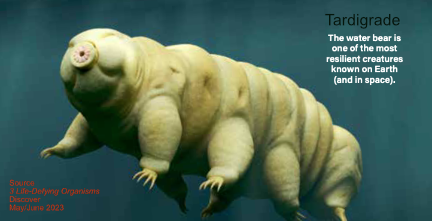
Tardigrades can survive crushing pressure of the ocean floor, DNA shredding radiation, the vacuu of space and eventemperatures just 1 degree above absolute zero, and hte evaporation of all the water in their cells. Don't believe it.
Research ... American Scientist article - Tardigrades
What about the Immortal Jellyfish?
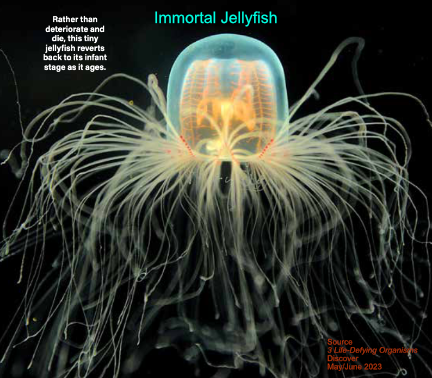
Ecosystems
Ecosystems (Populations, Environmental factors, Environments, Communities)
- Interdependent Relationships in their Environment & Ecosystems
- Matter & Energy Flow, Transfer & Cycles
- Dynamics, Functions, & Resilience
- Social Interations & Group Behavior ( Interdependent Functions Relationships & Resilience
Initial perceptual naive misconceptions (any age)
Misconceptions (Explanations, Naive understanding, Misconceptions, or Perceptual responses)
- See misconceptions for animals and plants
- Resources are infinite.
- Plants and animals will always be on Earth because the life cycle will continue forever.
- Dirt and bugs are bad. They are not necessary for anything good.
- Everything can be recycled.
Populations
- A change in a food web will only affect animals that prey on it.
- An animal that is high on the food web preys on all populations below it.
- A change in the prey population has no affect on the predator.
- If the size of one population in a food web is changed, all other populations in the web are changed in the same way.
- A food web is a food chain
- Animals are carnivores if they are big and ferocious. Herbivores are small and timid.
- Don't add plants to the web only prey and predator.
- See the top of the web as having the most energy. Or energy accumulates at the top.
- Populations on the top increase as the organisms below decrease.
- Characteristics of a population are created according to the needs of the individual or according to a predetermined grand plan.
- Characteristics are passed on by the bigger stronger organisms.
- Populations are either in equilibrium or decreasing depending on their position in the web.
- The needs and roles of a species are the same as those of similar species.
- Species live together in an ecosystem because they have compatible needs and behaviors.
- Plants rely on carbon dioxide from animals.
- Do not understand that animals energy comes from the sun.
- Deserts are dead waste lands where nothing could live or thrive.
Educator notes
Concepts Beginning (preschool - 7 years)
Environmental
- All animals depend on plants. Some animals eat plants for food.
- Other animals eat animals that eat the plants.
- Living organisms are found almost everywhere in the world.
- They are somewhat different in different parts of the world.
- Many materials can be recycled and used again.
Populations
- A population consists of all individuals of a species that occur together at a given place and time
Educator notes
Concepts Intermediate (7 years - 11 years)
Environmental
- The world has many different environments, and distinct environments support the life of different types of organisms.
- Some organisms will survive better in different parts of the world and some will not.
- An organism's patterns of behavior are related to the nature of that organism's environment, including the kinds and numbers of other organisms present, the availability of food and resources, and the physical characteristics of the environment.
- When the environment changes, some plants and animals survive and reproduce, and others die or move into new locations.
- Organisms interact with other organisms in addition to providing food (seed dispersal, plant pollination, lichens).
Populations - community
- Populations of organisms can be categorized by the function they serve in a community (producer and consumer).
- Plants and some microorganisms are producers- they make their own food. All animals, including humans, are consumers, which obtain food by eating other organisms.
- The population of an ecosystem depends on the resources available and abiotic factors, such as quantity of light and water, range of temperatures, and soil composition.
- Given adequate biotic and abiotic and no disease of predators, populations (including humans) increase at rapid rates.
- Lack of resources and other factors, such as predation and climate, limit the growth of a population in specific niches in the ecosystem.
- Relationships may be competitive or mutually beneficial.
- Mutually benefituak or symbiotic is when two or more different organisms (species) live in close physical association, typically to the advantage of both. As opposed to a parasite, which is an organism that lives in or on another organism (host species) and derives nutrients at the other organisms expense. All mistletoes species are parasites that attach to tree (oaks & poplars) branches (host) and siphon water and nutrients to survive. In winter, they are green and provide food and shelter for animals.
- Some species have adapted to each other to the point that they could not survive without each other. Require a community.
- Community is a group of interdependent organisms of different species that are growing and living together in a specific habitat.
Educator notes
- Environment & environmental factors - unit with plans, activities, & lab note book
- Community - A unit or packet with a sequence of activities & plans to develop a deeper understanding of the relationships of organisms & populations as communities within environments. Includes hands-on activities with plants, seeds (embryo, cotyledon, & seed coat), crickets, anoles, decomposers, and terrariums.
Concepts Literate (11+)
Environmental
- All organisms cause changes in the environment where they live.
- Some of these changes are detrimental to the organism or other organisms, and others are beneficial.
- Humans depend on their natural and constructed environments.
- Humans change environments in ways that can be either beneficial or detrimental for themselves and other organisms. In all environments organisms compete with each other for resources, including food, space, water, air, and shelter in order to survive.
- Over time matter is transferred from one organism to another repeatedly and between organisms and their environment. This total amount of matter remains the constant even though its form and location change. Energy can be change from one form to another in living organisms (energy from oxidizing food).
- Food webs identify the relationships among producers, consumers, and decomposers in an ecosystem.
- An ecosystem includes all populations living together and the physical environmental factors with which they interact.
- For ecosystems, the major source of energy is sunlight which is transferred by producers into chemical energy through photosynthesis.
- That energy then passes from organism to organism in food webs.
- Decomposers, primarily bacteria and fungi, are consumers that use waste materials and dead organisms for food.
- In the process of decomposing organic matter they create nutrients for plants.
- Wild fires can provide environment benefits when included as part of an ecosystem's normal cycle.
- Wild fire conditions include precipitation, relative humidity, atmospheric pressure, amount of plant vegetation, water stress on the plants, amount of organic litter (decaying matter, leaves, fallen timber, seasonal growth), source of ignition (human, lighting).
- Climate change -
Populations - community
- Food chains identify the relationships among producers and consumers.
- Food cycle includes producers, consumers, and decomposers.
Educator notes
- Environmental education & sustainability - Historical perspective of environmental education, state of environmental education, ICEE findings & recommendations, suggestions to help teachers become environmentally savvy, teacher's views of their needs, sample program goals, scoring guide for environmental concern, suggestions to assess curriculum, student environmental knowledge, misconceptions, teaching resources, & six questions & answers about environmental education
- Environment & environmental factors - unit with plans, activities, & lab note book
- Community - A unit or packet with a sequence of activities & plans to develop a deeper understanding of the relationships of organisms & populations as communities within environments. Includes hands-on activities with plants, seeds (embryo, cotyledon, & seed coat), crickets, anoles, decomposers, and terrariums.
- Ecosystem - A unit or project with a sequence of activities & plans to develop a deeper understanding of the interdependence required to maintin healthy ecosystems. Investigations include study of environmental factors, organisms and their needs, populations, communities, life cycles, food webs and energy cycle, water cycle, carbon dioxide - oxygen cycle, nitrogen cycle, and decomposition.
- Environmental health unit - includes lesson plans, activities, lab notes (worksheets, word bank & key ideas). Content includes: Brainstorm prior knowledge of Nature, Create an environmental model with (environmental factors, organism in the environment, & environmental interactions to maintain a balanced ecosystem of nature, humans, needs for human survival and environmental variables), Environmental Health Disasters Activity, Historical decisions with Positive & Negative Environmental Impacts, Making healthy environmental decisions today, Influences on environmental decisions, Decision Making for personal and environmental health, Implementation of environmental decisions, and Review
Climate change notes
- Plant and animal populations outgrow environmental resources and become endangered or extinct.
- Human population grow greater than natural resources and require human intervention. (Anthropocene era)
- Agriculture replaces natural ecosystems.
- Freshwater is decreasing faster than it's being replentished.
- Nitrogen and phosphorus cycles are altered with farming and fertilizers.
- Ocean fish are being harvested faster than they are able to be replentished.
- Acidity of ocean and acid rain is increasing.
- Carbon Dioxide in the atmosphere is increasing and climate change resulting from the greenhouse effect.
- Climate change
- Size of prey eaten by mammalian predators according to their body mass in Kg.
- Wild fires - conditions for starting them and their spread include: temperature, precipitation, relative humidity, atmospheric pressure, amount of plant vegetation, water stress on the plants, amount of organic litter (decaying matter, leaves, fallen timber, seasonal growth), source of ignition (human, lighting)
Goals related to climate change and possible pathways to address rising sea levels. Source Science June 2021
Relationship of the mass of prey to predators.
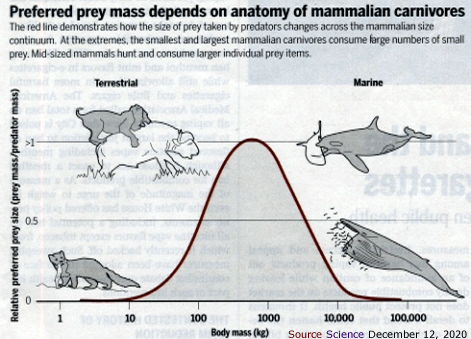
Heredity & Evolution
Heredity
- Inheritance of Traits
- Variation of Traits
Evolution See also evolution & equilibrium in process concepts
- Evidence of Common Ancestry (Unity) & Diversity
- Natural Selection
- Adaptations
- Biodiversity and Humans
Initial perceptual naive misconceptions (any age)
Misconceptions (Explanations, Naive understanding, Misconceptions, or Perceptual responses)
- See misconceptions for organisms, animals, and plants
- Evolution is goal directed.
- Evolution is driven by need.
- People are different enough to be categorized into different races.
- Dinosaurs and prehistoric people lived at the same time.
Educator notes
Concepts Beginning (preschool - 7 years)
Heredity
- Living organisms (plants & animals) look like their parents. Babies look like their parents, seeds grow into plants like the plant that grew the seeds.
- Modern organisms may resemble extinct organisms.
- Objects and organisms can be changed to function for better or worse.
Evolution
- Evolution is driven by reproductive multiplication, variation by mutation, and recombination, adaptation with selection, proliferations of healthy functioning descendants.
- See also evolution & equilibrium in process concepts
Educator notes
- The mechanics of evolution are responsible for every single creature that lives on the face of the Earth and ever has or will live.
Concepts Intermediate (7 years - 11 years)
Heredity
Evolution
- Changes may not be noticed on a scale of a human's life time.
- However, these changes become large as the number of lifetimes become large.
- See also evolution & equilibrium in process concepts
Educator notes
- The mechanics of evolution are responsible for every single creature that lives on the face of the Earth and ever has or will live. See evolution teacher's guide
- Newsweek October 25, 2004. p 66. President Bush's Council on Bioethics objected to - "computer-brain hookups that would enable us to download the Oxford English Dictionary."
Concepts Literate (11+)
Heredity
Evolution
- Present conditions such as the salt in the oceans, continental drift, erosion of land forms, changes in organisms... can be explained as gradual and sporadic.
- Evolution is the idea of the present arising from materials and forms of the past.
- Sometimes a series of changes occurs so slowly or so rapidly that it is difficult to document the evolution. See evalution teachers guide
- In evolving systems, change can be gradual, steady, repetitive, irregular, or in more than one way at the same time. For example: whales blow holes moved from the snout to the top of the head in 3 million years. Polar bears developed the ability to survive on a high fat diet of seal blubber in 300 000 years. Chinook salmon body size decreased in response to commercial fishing in 90 years. Mosquitoes colonized London's Underground in 1863 and now can not mate with their above-ground relatives. Green anole lizards at Indian River Lagoon, Florida adapted to the invasion of brown anoles with larger toepads and more scalesto climb higher and cling better to branches in 15 years. Tawny owls come in two colors: light gray and reddish brown. As the climate becomes milder with less snow there has been a steady increase in the proportion of red brown owls. Discover Magazine. Life in the Fast Lane by Jane Braxton Little. March 2015.
- Human design suggests current features of the human body are designs that have been handed down, or evolved, to create human properties for characteristics that could have been designed better. Features like an appendix, tender naked skin prone to cuts, bruises, bites, and sunburn, back or spinal column that is efficient for four legged creatures than two or bipedal creatures, pertuberances above the nostrils, weak teeth that are prone to tooth decay, slow runners, weak animals ( chimps are three times as strong humans even thought they are smaller than us), a brain that stacks brain parts from a brain stem, to a hind brain (respiration, balance, alertness - .5 billion years old from dinosaurs), mid brain (visual, auditory, reflexes and controls eye movement), and fore brain (language, culture, and decision making). ... However, humans are able to detect a single photon in the dark and are able to hear sound a sound wave that is less than the diameter of hydrogen atom, and hemoglobin is able to adapt to differen air pressures.
- See also evolution & equilibrium in process concepts
Educator notes
- Evolutionary theory is the best scientific explanation for the unity and diversity of life. Miller & Levine
- The mechanics of evolution are responsible for every single creature that lives on the face of the Earth and ever has or will live.
- RNA. There are many kinds of RNA:
- mRNA (messenger RNA) this molecule transfers DNA's code out of a cell's nucleus to guide protein construction.
- Transfer RNA delivers amino acids to the ribosome.
- Other RNA's silence genes or affect their activity.
- NOTCH gene family controls the timing of development in everyting from fruit flies to whales. In human brain evolution NOTCH2 and NOTCH2NL are thought to have an important role in brain development.
- CRISPR-Cas9 system has two molecules used to change (mutate?) DNA. 1. an enzyme, Cas9, which acts as molecular scissors to cut two strands of DNA in a genome so DNA can be added or removed. 2. a piece of RNA (gRNA) to guide the Cas9 to the right part of the genome so it cuts at the right place of the genome.
- CRISPEY (Cas9) is a retron derived base editor, which has been used to change genomes of single cell organisms. It is a highly efficient and precise system to edit parallel genomes to measure the fitness effects of thousands of natural genetic variants in yeast. However, it may have the potential to alter genomes of multicell organisms. It takes retrons, whose RNA matches yeast genes with a mutated base. Combines them with CRISPR's RNA, which guides it to the targeted DNA. The Cas9 enzyme acts as CRISPR's scissors and cuts the DNA. Then the cells's DNA replaces the yeast gene with DNA made by the retron's reverse transcriptase.
- Newsweek July 31, 2006 - Jonathan Alter. July 19, 2006 - President Bush casts his first VETO on a bill that would allow surplus embryos from fertility clinics to be used for pathbreaking research instead of being tossed out in the garbage. If using embryos for medical research is "murder" (Bush's position), then how can he support the existence of fertility clinics?
- Horizontal gene transfer (HGT) is common between species of bacteria, bacteria and plants, and sometimes insects and plants. Such as in the sap sucking whitefly. Millions of years ago, the gene, BtPMaT1, which plants use to detoxify a poison (phenolic glycoside) they make as a defense mechanism was transferred from plants to the fly. When the fly acquired the gene, it became possible for it to feed on hundreds of plants without harm. Making it a significant pest for agriculture.
- See evolution teacher's guide
- Investigation & activities
- Knowledge base with concepts & misconceptions
- Science Standards archives
- Professional development
- Vocabulary
- STEM timeline shows arrival of life on Earth
